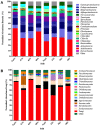Microbial Community Structure and Function of Soil Following Ecosystem Conversion from Native Forests to Teak Plantation Forests
- PMID: 28018311
- PMCID: PMC5145857
- DOI: 10.3389/fmicb.2016.01976
Microbial Community Structure and Function of Soil Following Ecosystem Conversion from Native Forests to Teak Plantation Forests
Abstract
Soil microbial communities can form links between forest trees and functioning of forest soils, yet the impacts of converting diverse native forests to monoculture plantations on soil microbial communities are limited. This study tested the hypothesis that conversion from a diverse native to monoculture ecosystem would be paralleled by a reduction in the diversity of the soil microbial communities. Soils from Teak (Tectona grandis) plantations and adjacent native forest were examined at two locations in Trinidad. Microbial community structure was determined via Illumina sequencing of bacterial 16S rRNA genes and fungal internal transcribed spacer (ITS) regions, and by phospholipid fatty acid (PLFA) analysis. Functional characteristics of microbial communities were assessed by extracellular enzyme activity (EEA). Conversion to Teak plantation had no effect on species richness or evenness of bacterial or fungal communities, and no significant effect on EEA. However, multivariate analyses (nested and two-way crossed analysis of similarity) revealed significant effects (p < 0.05) of forest type (Teak vs. native) upon the composition of the microbial communities as reflected in all three assays of community structure. Univariate analysis of variance identified two bacterial phyla that were significantly more abundant in the native forest soils than in Teak soils (Cyanobacteria, p = 0.0180; Nitrospirae, p = 0.0100) and two more abundant in Teak soils than in native forest (candidate phyla TM7, p = 0.0004; WS6, p = 0.044). Abundance of an unidentified class of arbuscular mycorrhizal fungi (AMF) was significantly greater in Teak soils, notable because Teak is colonized by AMF rather than by ectomycorrihzal fungi that are symbionts of the native forest tree species. In conclusion, microbial diversity indices were not affected in the conversion of native forest to teak plantation, but examination of specific bacterial taxa showed that there were significant differences in community composition.
Keywords: and Illumina; archaea; bacteria; forest; fungi; soil.
Figures







Similar articles
-
Long lasting effects of the conversion from natural forest to poplar plantation on soil microbial communities.Microbiol Res. 2016 Jan;182:89-98. doi: 10.1016/j.micres.2015.10.002. Epub 2015 Oct 20. Microbiol Res. 2016. PMID: 26686617
-
Alterations in Arbuscular Mycorrhizal Community Along a Chronosequence of Teak (Tectona grandis) Plantations in Tropical Forests of China.Front Microbiol. 2021 Nov 26;12:737068. doi: 10.3389/fmicb.2021.737068. eCollection 2021. Front Microbiol. 2021. PMID: 34899624 Free PMC article.
-
Change in bacterial community structure in response to disturbance of natural hardwood and secondary coniferous forest soils in central taiwan.Microb Ecol. 2011 Feb;61(2):429-37. doi: 10.1007/s00248-010-9748-9. Epub 2010 Sep 29. Microb Ecol. 2011. PMID: 20878522
-
Conversion of rainforest into agroforestry and monoculture plantation in China: Consequences for soil phosphorus forms and microbial community.Sci Total Environ. 2017 Oct 1;595:769-778. doi: 10.1016/j.scitotenv.2017.04.012. Epub 2017 Apr 11. Sci Total Environ. 2017. PMID: 28410526
-
Pine Forest Plantations in the Neotropics: Challenges and Potential Use of Ectomycorrhizal Fungi and Bacteria as Inoculants.J Fungi (Basel). 2025 May 20;11(5):393. doi: 10.3390/jof11050393. J Fungi (Basel). 2025. PMID: 40422727 Free PMC article. Review.
Cited by
-
High Diversity of β-Glucosidase-Producing Bacteria and Their Genes Associated with Scleractinian Corals.Int J Mol Sci. 2021 Mar 29;22(7):3523. doi: 10.3390/ijms22073523. Int J Mol Sci. 2021. PMID: 33805379 Free PMC article.
-
Amplicon-based assessment of bacterial diversity and community structure in three tropical forest soils in Kenya.Heliyon. 2022 Nov 15;8(11):e11577. doi: 10.1016/j.heliyon.2022.e11577. eCollection 2022 Nov. Heliyon. 2022. PMID: 36411924 Free PMC article.
-
Spatial assortment of soil organisms supports the size-plasticity hypothesis.ISME Commun. 2022 Oct 19;2(1):102. doi: 10.1038/s43705-022-00185-6. ISME Commun. 2022. PMID: 37938741 Free PMC article.
-
Advances in monitoring soil microbial community dynamic and function.J Appl Genet. 2020 May;61(2):249-263. doi: 10.1007/s13353-020-00549-5. Epub 2020 Feb 15. J Appl Genet. 2020. PMID: 32062778 Review.
-
Phylogenetic Reassessment, Taxonomy, and Biogeography of Codinaea and Similar Fungi.J Fungi (Basel). 2021 Dec 20;7(12):1097. doi: 10.3390/jof7121097. J Fungi (Basel). 2021. PMID: 34947079 Free PMC article.
References
-
- Augusto L., Ranger J., Binkley D., Rothe A. (2002). Impact of several common tree species of European temperate forests on soil fertility. Ann. For. Sci. 59, 233–253. 10.1051/forest:2002020 - DOI
-
- Beare M. H., Parmelee R. W., Hendrix P. F., Cheng W., Coleman D. C., Crossley D. A., Jr. (1992). Microbial and faunal interactions and effects on litter nitrogen and decomposition in agroecosystems. Ecol. Monogr. 62, 569–591. 10.2307/2937317 - DOI
-
- Benjamini Y., Hochberg Y. (1995). Controlling the false discovery rate: a practical and powerful approach to multiple testing. J. R. Stat. Soc. B 57, 280–300.
LinkOut - more resources
Full Text Sources
Other Literature Sources

